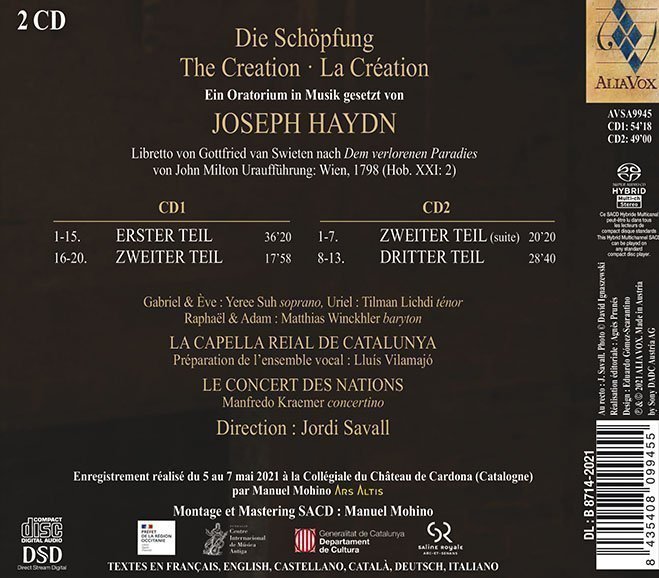JOSEPH HAYDN
La Création
Jordi Savall, La Capella Reial de Catalunya, Le Concert des Nations
25,99€
ALIA VOX
AVSA9945
CD1 : 54’18
CD2 : 49’00
Die Schöpfung
The Creation · La Création
Ein Oratorium in Musik gesetzt von
JOSEPH HAYDN
Libretto von Gottfried van Swieten nach Dem verlorenen Paradies von John Milton
Uraufführung: Wien, 1798 (Hob. XXI: 2)
CD1
1-15. ERSTER TEIL 36’20
16-20. ZWEITER TEIL 17’58
CD2
1-7. ZWEITER TEIL (suite) 20’20
8-13. DRITTER TEIL 28’40
SOLISTES
Gabriel & Ève : Yeree Suh soprano
Uriel : Tilman Lichdi ténor
Raphaël & Adam : Matthias Winckhler baryton
LA CAPELLA REIAL DE CATALUNYA
Préparation de l’ensemble vocal : Lluís Vilamajó
LE CONCERT DES NATIONS
Manfredo Kraemer concertino
Direction : Jordi Savall
Enregistrement réalisé du 5 au 7 mai 2021
à la Collégiale du Château de Cardona (Catalogne)
par Manuel Mohino
Montage et mastering SACD : Manuel Mohino
TEXTES EN FRANÇAIS, ENGLISH, CASTELLANO, CATALÀ, DEUTSCH, ITALIANO
Joseph Haydn & The Creation
My interest and fascination for the work of Joseph Haydn date back to 1960-64, when I was completing my music and cello studies at the Barcelona Conservatoire and had the opportunity to discover and study some of the composer’s most beautiful quartets. During that time, two special pocket scores always accompanied in my apprenticeship of musical forms and the fascinating discovery of great masterpieces of musical creation: one was J. S. Bach’s The Art of Fugue and the other Haydn’s The Seven Last Words of Christ on the Cross. Two wonderful works that I later recorded under the ASTRÉE label a few years after having founded and prepared the appropriate music ensembles: L’Art de la Fugue, recorded in March, 1986, with 4 solo wind instruments and 4 violas da gamba from the ensemble HESPÈRION XX, following a year of concerts throughout Europe to celebrate the 300th anniversary of Bach’s birth. It was followed four years later, in December, 1990, by the recording of Haydn’s Seven Last Words of Christ on the Cross, two years after the creation of the orchestra LE CONCERT DES NATIONS. The latter work made such a profound impression on me that I felt compelled to “revisit” it 16 years later in October, 2006, and perform it at the Oratorio de la Santa Cueva (Holy Cave Oratory) in Cadiz, for which the work was commissioned and where it was first performed during Holy Week, 1787.
The next objective was to perform The Creation, one of the composer’s last masterpieces, with our orchestra LE CONCERT DES NATIONS playing instruments from the time of Haydn. It would not come about until – (thanks to the work carried out in our Professional Academies) our choral ensemble LA CAPELLA REIAL DE CATALUNYA comprised a fine choir specialising in the style of the period and, moreover, capable of singing in German. 15 years after the Cadiz recording, we achieved this new objective, this new Creation, which we now have the immense pleasure of presenting to you.
+ information in the CD booklet
JORDI SAVALL
Bellaterra, 1st September, 2021
Translated by Jacqueline Minett
Critics
”
“Baignée de lumière, l’interprétation de Jordi Savall démontre une recherche de timbres, de couleurs, de climats, ainsi qu’une conception dramatique des plus soignées."
ResMusica – 30 décembre 2022. Alain Huc de Vaubert.
”
“Jordi Savall vuelve a recurrir a su fórmula mágica de tantos años contar con los mejores instrumentistas, coristas y cantantes y aplicarle a la partitura un estudio profundo sobre sus posibilidades expresivas, sus necesidades estilísticas y sus límites retóricos. Y así sucede en este caso, con una versión magistral del Oratorio La Creación de Haydn."
Andrés Moreno Mengibar · Disco ExcepcionalSCHERZO, febrero 2022 (png)
”
“Savall acepta el desafío de Haydn, con una lectura de vitalidad desbordante y energía absolutamente envidiable, que acoge al espíritu de la reconstrucción histórica y su empuje vívido, en perfecta armonía con los criterios estilísticos del clasicismo más ortodoxo."
Álvaro de Dios - Recomendado *****RITMO, marzo 2022 (pdf)
”
“S’il fallait definir par un seul adjectif la conception de La Création par Savall, c’est celui de ‘lumineuse’ qui s’imposerait."
Jean Lacroix - Jocker absolu.CRESCENDO, Février 2022 (pdf)
”
“De Haydn, Jordi Savall avait déjà enregistré Les Sept Dernières Paroles du Christ en croix (2007) – pour La Création (créé en 1798), le chef gambiste catalan retrouve Le Concert des Nations et la Capella Reial de Catalunya. D’une exceptionnelle cohérence artistique, la lecture de Jordi Savall élabore une vision à la fois distanciée (cuivres lointains dès l’ouverture, dans le chaos primordial) et aussi profonde et très poétique. Il fait de la partition, un manifeste inondé de lumière,..."
www.classiquenews.com








Share